Lebanese Shia Muslims
Lebanese Shia Muslims (Arabic: المسلمون الشيعة اللبنانيون), communally and historically known as matāwila (Arabic: متاولة, plural of متوال mutawālin;[1] pronounced as متوالي metouali or matawali in Lebanese Arabic[2]), are Lebanese people who are adherents of the Shia Islam in Lebanon, which plays a major role along Lebanon's main Sunni, Maronite and Druze sects. Today, Shia Muslims are considered to be the largest sect in Lebanon, constituting about 41% of Lebanon's total population. (~65% of the Muslim population)
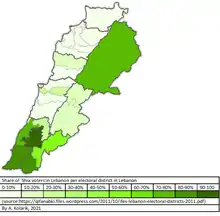 Distribution of Shi'a Muslims in Lebanon | |
| Total population | |
|---|---|
| ~2,210,000 | |
| Languages | |
| Vernacular: Lebanese Arabic | |
| Religion | |
| Islam (Shia Islam) |
| Part of a series of articles on |
| Lebanese people |
|---|
 |
|
|
Most Lebanese Shiites live in Southern Lebanon, the northern Beqaa Valley and Beirut. The great majority of Shia Muslims in Lebanon are Twelvers. A minority are Ismailis and Alawites, who are recognized as separate sects.[3][4]
Lebanese Shiites form the only major Twelver community in the Levant. Under the terms of an unwritten agreement known as the National Pact between the various political and religious leaders of Lebanon, Shias are the only sect eligible for the post of Speaker of Parliament.[5][6][7][8]
History
Origins
The cultural and linguistic heritage of the Lebanese people is a blend of both indigenous elements and the foreign cultures that have come to rule the land and its people over the course of thousands of years. In a 2013 interview the lead investigator, Pierre Zalloua, pointed out that genetic variation preceded religious variation and divisions: "Lebanon already had well-differentiated communities with their own genetic peculiarities, but not significant differences, and religions came as layers of paint on top. There is no distinct pattern that shows that one community carries significantly more Phoenician than another."[9]
Lebanon throughout its history was home of many historic peoples who inhabited the region. The Lebanese coast was mainly inhabited by Phoenician Canaanites throughout the Bronze and Iron ages, who built the cities of Tyre, Sidon, Byblos and Tripoli, which was founded as a center of a confederation between Aradians, Sidonians, and Tyrians. Further east, the Bekaa valley was known as Amqu in the Bronze Age, and was part of Amorite kingdom of Qatna and later Amurru kingdom, and had local city-states such as Enišasi. During the Iron Age, the Bekaa was dominated by the Aramaeans, who formed kingdoms nearby in Damascus and Hamath, and established the kingdom of Aram-Zobah where Hazael might have been born, and was later also settled by Itureans, who were likely Arabs themselves. These Itureans inhabited the hills above Tyre in Southern Lebanon, historically known as Jabal Amel, since at least the times of Alexander the Great, who fought them after they blocked his army's access to wood supply.[10]
During Roman rule, Aramaic became the lingua franca of the entire Levant and Lebanon, replacing spoken Phoenician on the coast, while Greek was used as language of administration, education and trading. It is important to note that most villages and towns in Lebanon today have Aramaic names, reflecting this heritage. However, Beirut became the only fully Latin speaking city in the whole east. On the coast, Tyre prospered under the Romans and was allowed to keep much of its independence as a "civitas foederata".[11] On the other hand, Jabal Amel was inhabited by Banu Amilah, its namesake, who have particular importance for the Lebanese Shia for adopting and nurturing Shi'ism in the southern population. The Banu Amilah were part of the Nabataean Arab foederati of the Roman Empire, and they were connected to other pre-Islamic Arabs such as Judham and Balqayn, whose presence in the region likely dates back to Biblical times according to Irfan Shahîd.[12] As the Muslim conquest of the Levant reached Lebanon, these Arab tribes received the most power which encouraged the non-Arabic-speaking population to adopt Arabic as the main language.[13]
Early Islamic period

According to the accounts of Al-Maqdisi (c. 966-985) and Nasir Khusraw (c. 1045), Shiites formed a majority in Tyre (Sūr), Tripoli, Tiberias, Amman and Qadas, whose rustaq (town) was all of Jabal Amel.[14][15][16][17][18][19] Shiites were also present in significant numbers in Nablus, Homs and Aleppo, where Twelver Shiite dynasties reigned under the Hamdanids (890–1004) and Mirdasids (1024–1080).[20][21][22][23] Aleppo, however, preserved a significant Sunni population who were entitled to their own qadi.[20] Shiite presence in the urban centers implied a Twelver–Isma'ili fusion, with Tyre and Tripoli producing both Twelver scholars and Isma'ili missionaries.[14][15][13]
In the eleventh century, two independent Twelver Shiite emirates covered parts of Lebanon: the Banu Ammar in Tripoli and Banu Mirdas in Sidon and the Bekaa valley.[24][25] While Banu Mirdas rivaled the authority of Fatimid governors in Syria, the Banu Ammar of Tripoli broke off from Fatimid rule in 1070 and ruled a territory which stretched between Jableh and Jbeil. They invested large sums in turning the city a famous center for learning, founding a "House of Knowledge" that attracted scholars, as well as a notable library of 100,000 volumes.[26]
Late period

Upon the arrival of the First Crusade, Tripoli and Tyre experienced a drastic upheaval. Many Muslims in the two cities were killed or departed to the interior, and were replaced by Franks. Following the fall of Tripoli in 1109, many Shiites abandoned Tripoli and likely settled in Keserwan, where a Shiite community may have already been established in the 10th century, and the Beqaa Valley where the Tripoli's qadi Fakhr al-Mulk ibn Ammar was allotted land in nearby Zabadani.[14][13]
A similar thing may have followed further south. The Frankish sweep across the upper Jordan Valley (Hula Valley), Tiberias and the Galilee in 1099 prompted a Shia influx into the rest of Jabal Amel, where Frankish control was only extended with the fortification of Toron in 1106.[27][28] Another Shia influx followed after the Venetian Crusade on Tyre in 1124.[28][14][13][29][30] The Bekaa valley remained under Muslim rule and Shiites there were on good terms with Bahramshah (1182–1230), whose gesture of welcoming a prominent Shia scholar in Baalbek "gave morale to the Shiites in the district" according to al-Dhahabi.[14]
Mamluk period
By the early 14th century, Jabal Amel was becoming the Twelver Shia center of the Levant. With Shiism losing ground in Aleppo following Mamluk takeover, a stream of scholars shifted to Jabal Amel, and the area probably received migrants from there as it provided refuge from Sunni rigor.[13] Jabal Amel came to act as a refuge for Shias in adjacent areas escaping the Kisrawan campaigns (1292–1305) and Sunni authority in the Beqaa valley.[13][31] Jezzine and Karak Nuh replaced Aleppo and Tripoli as centers of Shiite learning in the Levant, and Shiite scholars enjoyed protection under Shia chiefs starting from Husam ad-Din Bishara in 1187 until the crisis of 1781.[32][31]
In muharram of 1305, the Mamluk army under the command of Aqqush al-Afram devastated the mountain-dwelling Shia community of Keserwan. The campaign was part of the Mamluks' efforts to subdue Keserwan since 1290, and came in after a band of Keserwanis reportedly attacked the Mamluk army while retreating from Battle of Wadi al-Khaznadar. The region fell after eleven days of brutal fighting, driving an influx of Shiites toward the Beqaa valley and Southern Lebanon, while a humbled minority stayed.[31][14][33] In 1384, the Mamluks also executed Muhammad Jamaluddin al-Makki al-Amili, the most prominent Shia scholar after falsely being charged as a ghulat.[34][35]
Under Ottoman rule
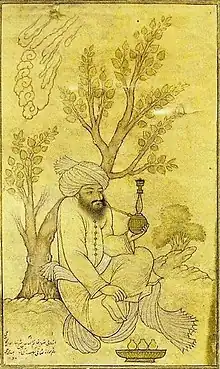
The Levant fell to the Ottomans in 1516, bringing about a new period in the region. Under the Ottomans, Local Shias often came into conflict with Ottoman-assigned governors of Tripoli, Sidon and Damascus, who derogatorily referred to them as Qizilbash in their documents as a means to delegitimize them or justify punitive campaigns against them.[36] During most of the Ottoman period, the Shia largely maintained themselves as 'a state apart'. Unlike the Druze and Christians, the Shiite emirs were regularly denounced for their religious identity and persecuted as Qizilbash heretics per Ebussuud Efendi's definitions, and lacked separate recognition by the Ottoman millet system.[35][37][38] Their peculiarity caused western travelers to describe them as a distinct society.[39][38]
The Ottomans preferred to rely on local intermediaries rather than forcibly imposing foreign ones, and as part of their effort they confirmed iltizam (tax collecting) of Shiite areas in Jabal Amel, Bekaa valley and Mount Lebanon to local Shia families.[35] These included the Munkars, Ali al-Saghirs and Sa'abs of Jabal Amel, the Harfush of Bekaa and Hamade family of northern Mount Lebanon.[35] These families played an important role in regional affairs, and their territories occasionally stretched as far as the outskirts of Hama and Palmyra in the Syrian Desert.[35] They frequently came into conflict with Ottoman governors to whom they refused to remit taxes, and were involved in alliances and rivalries with other feudal families.[35][31][40]
During this time period, Shiites built particularly close ties with the Safavids of Iran, contributing significantly to Iran's conversion into Shia Islam. Chief among their clerics was Muhaqqiq al-Karaki from Karak Nuh, who achieved significant power in religion and governance during the reign of Shah Tahmasp I, so much so that the latter told him: ''You are the real king and I am just one of your agents". These contacts greatly angered the Ottomans, who derogatorily referred to them as Qizilbash.[41] Another prominent cleric was Baha'uddin al-Amili, who authored astronomical and mathmatical treatises, and is responsible for many architectural feats in the city of Isfahan.[42][31]Thus, Shia-Ottoman conflict in Lebanon was a marriage of politics and religion.[41]
Political crisis

By the late 18th century, Shiite influence much diminished in favor of an increasingly powerful Maronite–Druze alliance which reached heights under the Sunni (and later Maronite) Shihab dynasty, a wealthy family who came to be favored by the Ottoman governors. This was decisive for the Hamadas of Mount Lebanon, who were left physically broken by a 20,000-strong Ottoman military campaign in 1693 and were eventually defeated by the Shihabs in 1771, prompting a Shiite influx into the Bekaa valley.[35][43][31] The Harfush underwent a similar process after they fell out of Ottoman grace in 1865, after which they were deported to Edirne.[35] In Jabal Amel, the newly appointed Jazzar Pasha (1776–1804) initially maintained a neutral relation with the Shiite chief Nasif al-Nassar. Their relations soured in Septembr 1781, when, according to the local Shia chronicler Ali al-Subayti, the Shia sheikh of Hunin requested al-Jazzar's intervention against Nasif.[44] Jazzar continued to eliminate all of the rival Shiite chiefs and conquer their fortress towns in 1781, destroying all of their religious libraries in the process.[45] The effort was commended by the Sublime Porte in a letter filled with rhapsodic praise and a promise to al-Jazzar of the empire's unyielding support to "clean the land of the filth of their existence", in reference to the Shia clans.[35] This marked the end of Shia autonomy in Jabal Amel.[35]
During the crises, many Shiite villages were left desolate and uninhabited, and in Jezzine and Keserwan witnessed further Christian migration under patronage of the Shihabs and Jumblatts.[31][45][46] Fighting and political instability further affected Shiite demographics, who by 1861 accounted for only 11% of the population within Lebanon's territories.[46][31] An account of Comte de Volney, who visited Lebanon between 1783 and 1785, recounts the state of Shiites he had witnessed:
"The Metoualis are almost annihilated due to their revolts [...]; their name is soon to be extinct".[39]
Jazzar's harsh policies raised fury among Shiite villagers, who subsequently held meetings in an effort to organise guerrilla attacks against Jazzar's garrisons, acts that persisted throughout his governorship.[43] The period witnessed swift uprisings against his rule in Tyre and Chehour, and the insurgents managed to temporarily seize the Tebine citadel in 1783. Insurgency continued until the end of al-Jazzar's rule in 1804, and famously involved Faris al-Nassif, Nassif al-Nassar's son.[43][31] In 1805, Bashir Shihab II mediated a treaty between the Shiites and Jazzar's successor, Sulayman Pasha al-Adil, in order to end the former's attacks. The agreement restored Shiite autonomy in Jabal Amel and granted a general amnesty for all Shia rebels, as well as a compensation for their losses after the battle of Yaroun, and granted the community the right to solve their internal problems without interference from the Ottoman governor.[43]
Tanzimat era
Following the start of the Tanzimat reforms and Egyptian–Ottoman war of 1839–1841, during which the Shiites assumed a central role in kicking out Ibrahim Pasha's army out of Syria, the Ottomans bestowed the Pasha title upon the Ali al-Saghirs, restoring considerable autonomy to Jabal Amel as a district under the Ali al-Saghirs until 1865, when it was incorporated into the Syria vilayet under direct Ottoman rule.[47][43] The Beqaa-based Harfushes were similarly deposed and deported to Edirne that same year.[35][43] It was during this period that orientalist travelers noted the impoverishment of the Shiites of Jabal Amel, who did not benefit from the subsequent reforms.[48] Great powers' influence continued during this period and further widened the gap, with the French backing the Maronites, the British backing the Druze, the Austrians backing the Catholics, the Russians backing the Greek Orthodox and the Sunnis naturally backed by the Ottomans, all of whom established schools and missionaries across the country.[49][43] However, Shiites were the only ones without any support from outside powers, and did not benefit from the newly founded institutions.[49]
In 1860, a civil conflict broke out in Mount Lebanon between the Druze and the Maronites, after which it spread to Damascus, Hauran and to a lesser extent the Galilee. Action among Shiites was sporadic and less intense, with Shiites either allying with the Druze or acting on their own. At one point Shiites also amassed a force of 8,000 to fight the Druze, who attacked and injured a prominent Shiite sheikh who was sheltering Christians in Jbaa, but the Druze ended up negotiating for a truce.[50] Many Christian refugees were reportedly given protection by the Shiites in Chyah and Jabal Amel, where they settled in a plethora of villages.[43] After chaos ended, the Shiites were put in charge of maintaining order in the Beqaa, around Damascus and Hauran, where they helped put down several Druze rebellions, and were incorporated into the military cadres in Damascus for their fighting capabilities.[43]
Ottoman dissolution
During the period of Ottoman dissolution (1908–1922), strong sentiments of Arab nationalism arose among the Arabs in the empire, who established many movements and underground societies. Shiites were susecptible to these sentiments, who also despised the Ottomans for a variety of reasons. Despite previous Ottoman reforms, Shiites were deprived of their civil and religious rights and felt that their religious identity was revoked, so much so that they had to observe some rituals in secret. By 1918, Ottoman soldiers were stationed at the entrance to mosques and hussainiyas to prevent public commemoration of Ashura.[49]
Shiites worked keenly through groups such as Young Arab Society (al-Fatat), participating in conventions and conferences including the Arab Congress of 1913.[49][51] Among the prominent ones at the time were Ahmad Rida, Ahmad Aref al-Zein and Abdul Karim al-Khalil, a native of Chyah who founded the Al-Muntada al-Adabi (The Literary Club) in 1905, which effectively acted as an incubator for the growing Arab nationalist movement. The club was an immediate success, swiftly reaching a membership of several thousand, mostly students, with branches in Syria and Iraq.[52] Abdul Karim and his colleagues were also the first to form and fund underground armed cells which called for armed action against the Ottomans.[53][54] Abdul Karim was executed with some of his colleagues in 1916 after his Arab nationalist activities were exposed by feudalist Kamel Assad, who received the Ottoman sultan in his house as a gesture of loyalty, garnering further criticism.[55][56] Alongside these movements, there was a substantial rise of local papers and magazines, including al-Irfan and al-Morooj magazines in 1909, and Jabal Amel newspaper in 1911.[49]
French mandate period
With the Ottoman withdrawal in 1918, the French entered Nabatieh and barred the local populace from carrying out political activity. Local chiefs rejected the demand, and instead hoisted the Arab flag in several villages.[43] Shiites participated in the Syrian nationalist movement and Syrian National Congress in 1919, and prominent Shiites such as Ahmad Rida often stated their support for Syrian unity and independence within the Kingdom of Syria, emphasizing their Arab identity, while simultaneously defending Shiite particularism.[51][48]

Following the official declaration of the Arab Kingdom of Syria in March 1920, anti-French riots and clashed broke out in the predominantly Shia areas of Jabal Amel and the Beqaa Valley. Rebels attacked French military bases and garrisons in their areas, and sectarian clashes also took place, notably in Ain Ebel, due to French arming and their perceived acceptance of French mandatory rule. The French sent an expedition of 4,000–6,000 soldiers lead by Colonel Niger to the south in an effort to pacify the Shiite rebels, devastating their villages and crushing Shiite rebels by June 1920.[43] The defeat dispersed thousands of peasants who feared harsh reprisals, and the high fines imposed on the villagers contributed to financial hardship in the region.[48]
The armed effort was paralleled by the nonviolent resistance movement lead by Abdul Husayn Sharafeddine since 1919, who demanded US support for Syrian unity during the King–Crane Commission visit. This angered the French, who encouraged an unsuccessful assassination attempt against him. Sharafeddine strongly denounced sectarian hostility as it only gave purpose for the French military presence. During the famous the conference of Wadi al-Hujayr on 24 April 1920, he called for the protection of Christians.
The Christians (Nasara) are your brethren in the country and in destiny. Show to them the love you show to yourselves. Protect their lives and possessions as you do to your own. Only by this can you face the conspiracy and put an end to the civil strife.[43]
This period of unrest ended in 1921 with a political amnesty offered by the French mandate authorities for all Shiite rebels who had took part in the fighting, with the intention to bind the Shia community in Lebanon to the new Mandate state.[48][43] When the Great Syrian Revolt broke out in 1925, the calm remained in Jabal Amel. Nevertheless, many Shiites joined the rebels in Syria, and played a central role in the battles of the Qalamoun Mountains and Akroum, where Shiites reportedly took a booty of more than 400 rifles and fifty horses from French forces.[57] Many Christians who fled their villages during the revolt were accommodated by Shia notables from Nabatieh and Bint Jbeil, an act that was appreciated by the local Christian clergy.
What the Shi'ites did for the Christians in the south will be cherished in our hearts for as long as Lebanon and the Christians remain. What happened should be written in gold. Long live Lebanon, Long live Lebanese unity and long live the Shiites.[43]
The region experienced a decade of stability following the revolt. Shiites had become largely accepting of Greater Lebanon for sectarian and non-sectarian reasons, and the establishment of the Ja'fari court further strengthened communal ties and validated a sense of particularism otherwise denied under the Ottomans.[48] Instead of armed rebellion and uprisings, protests and civil strikes in Shia areas became the medium to protest French policies and tobacco prices.[48][43] Shiites were later active in providing ammunition, manpower and assistance to Palestinian rebels during the 1936–1939 revolt in Palestine, which was co-administered from Bint Jbeil.[43]
Education
In the 19th century, Lebanon saw dramatic changes when missionaries started establishing schools throughout the country. While the French and Russians mainly encouraged Maronite and Orthodox active learning respectively, along with American Protestant missions in Beirut, the British established educational institutions in Druze areas, and Sunnis mainly benefitted from Ottoman state institutions. However, Shiites were the only ones who did not benefit from such activities. This neglectance continued into the early days of the French mandate.[43]
During the 1920s and 1930s, educational institutions became places for different religious communities to construct nationalist and sectarian modes of identification.[58] Shia leaders and religious clergy supported educational reforms in order to improve the social and political marginalization of the Shia community and increase their involvement in the newly born nation-state of Lebanon.[59] This led to the establishment of several private Shia schools in Lebanon, among them The Charitable Islamic ʿĀmili Society (al-Jamʿiyya al-Khayriyya al-Islāmiyya al-ʿĀmiliyya) in Beirut and The Charitable Jaʿfari Society (al-Jamʿiyya al-Khayriyya al-Jaʿfariyya) in Tyre.[59] While several Shia educational institutions were established before and at the beginning of the mandate period, they often ran out of support and funding which resulted in their abolishment.[59]
The primary outlet for discussions concerning educational reforms among Shia scholars was the monthly Shiite journal al-'Irfan, founded in 1909. In order to bring their demands (muṭālabiyya) to the attention of the French authorities, petitions were signed and presented to the French High Commissioner and the Service de l'Instruction Publique.[60] This institution – since 1920 headquartered in Beirut- oversaw every educational policy regarding public and private school in the mandate territories.[51] According to historian Elizabeth Thompson, private schools were part of "constant negotiations" between citizen and the French authorities in Lebanon, specifically regarding the hierarchical distribution of social capital along religious communal lines.[61] During these negotiations, petitions were often used by different sects to demand support for reforms. For example, the middle-class of predominantly urban Sunni areas expressed their demands for educational reforms through petitions directed towards the French High Commissioner and the League of Nations.[62]
Sayyid Abdul-Husayn Sharafeddine believed that the only way to ward off foreign political influence was to establish modern schools while maintaining Islamic teachings. In 1938, he built two schools, one for girls and another for boys, at his own expense. However, the girls' school did not last long due to financial difficulties and traditional views, prompting Sayyid Sharafeddine to transfer the girls and teach them in his own home. The boys' school was known as al-Ja'fariyya, and was able to continue despite financial difficulties.[43]
Ja'fari shar'ia courts
In January 1926, the French High Commissioner officially recognized the Shia community as an "independent religious community," which was permitted to judge matters of personal status "according to the principles of the rite known by the name of Ja'fari."[63] This meant that the Shiite Ja'fari jurisprudence or madhhab was legally recognized as an official madhhab, and held judicial and political power on multiple levels.[64] The institutionalization of Shia Islam during this period provoked discussions between Shiite scholars and clergy about how Shiite orthodoxy should be defined. For example, discussions about the mourning of the martyrdom of Imam Husain during Ashura, which was a clandestine affair before the 1920s and 1930s, led to its transformation into a public ceremony.[65]
On the other hand, the official recognition of legal and religious Shiite institutions by the French authorities strengthened a sectarian awareness within the Shia community. Historian Max Weiss underlines how "sectarian claims were increasingly bound up with the institutionalization of Shi'i difference."[66] With the Ja'fari shar'ia courts in practice, the Shia community was deliberately encouraged to "practice sectarianism" on a daily basis.
Sub-groups
Shia Twelvers (Metouali)

Shia Twelvers in Lebanon refers to the Shia Muslim Twelver community with a significant presence throughout Lebanon.
The jurisdiction of the Ottoman Empire was merely nominal in the Lebanon. Baalbek in the 18th century was really under the control of the Metawali, which also refers to the Shia Twelvers.[35] Metawali, Metouali, or Mutawili, is an archaic term used to specifically refer to Lebanese Twelver Shias in the past. The term was a way to distinguish the uniqueness and unity of the community. The term 'mutawili' is also the name of a trustee in Islamic waqf-system.
Seven Shia (Mutawili) villages that were reassigned from French Greater Lebanon to the British Mandate of Palestine in a 1924 border-redrawing agreement were forcibly depopulated during the 1948 Arab-Israeli War and repopulated by Jews.[67] The seven villages are Qadas, Nabi Yusha, al-Malikiyya, Hunin, Tarbikha, Abil al-Qamh, and Saliha.[68] The inhabitants in turn fled to Lebanon.[67]
In addition, the Shia Twelvers in Lebanon have close links to the Syrian Shia Twelvers.[69]
Alawites
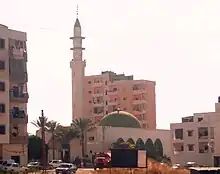
There are an estimated 50,000[3][70] Alawites in Lebanon, where they have lived since at least the 16th century.[71] They are recognized as one of the 18 official Lebanese sects, and due to the efforts of an Alawite leader Ali Eid, the Taif Agreement of 1989 gave them two reserved seats in the Parliament. Lebanese Alawites live mostly in the Jabal Mohsen neighbourhood of Tripoli, and in 10 villages in the Akkar region,[72][73][74] and are mainly represented by the Arab Democratic Party. Bab al-Tabbaneh, Jabal Mohsen clashes between pro-Syrian Alawites and anti-Syrian Sunnis have haunted Tripoli for decades.[75]
Isma'ilis
Isma'ilism, or "Sevener Shi'ism", is a branch of Shia Islam which emerged in 765 from a disagreement over the succession to Muhammad. Isma'ilis hold that Isma'il ibn Jafar was the true seventh imam, and not Musa al-Kadhim as the Twelvers believe. Isma'ili Shi'ism also differs doctrinally from Imami Shi'ism, having beliefs and practices that are more esoteric and maintaining seven pillars of faith rather than five pillars and ten ancillary precepts.
Though perhaps somewhat better established in neighbouring Syria, where the faith founded one of its first da'wah outposts in the city of Salamiyah (the supposed resting place of the Imam Isma'il) in the 8th century, it has been present in what is now Lebanon for centuries. Early Lebanese Isma'ilism showed perhaps an unusual propensity to foster radical movements within it, particularly in the areas of Wadi al-Taym, adjoining the Beqaa valley at the foot of Mount Hermon, and Jabal Shuf, in the highlands of Mount Lebanon.[76]
The syncretic beliefs of the Qarmatians, typically classed as an Isma'ili splinter sect with Zoroastrian influences, spread into the area of the Beqaa valley and possibly also Jabal Shuf starting in the 9th century. The group soon became widely vilified in the Islamic world for its armed campaigns across throughout the following decades, which included slaughtering Muslim pilgrims and sacking Mecca and Medina—and Salamiyah. Other Muslim rulers soon acted to crush this powerful heretical movement. In the Levant, the Qarmatians were ordered to be stamped out by the ruling Fatimid, themselves Isma'ilis and from whom the lineage of the modern Nizari Aga Khan is claimed to descend. The Qarmatian movement in the Levant was largely extinguished by the turn of the millennium.[76]
The semi-divine personality of the Fatimid caliph in Isma'ilism was elevated further in the doctrines of a secretive group which began to venerate the caliph Hakim as the embodiment of divine unity. Unsuccessful in the imperial capital of Cairo, they began discreetly proselytising around the year 1017 among certain Arab tribes in the Levant. The Isma'ilis of Wadi al-Taym and Jabal Shuf were among those who converted before the movement was permanently closed off a few decades later to guard against outside prying by mainstream Sunni and Shia Muslims, who often viewed their doctrines as heresy. This deeply esoteric group became known as the Druze, who in belief, practice, and history have long since become distinct from Isma'ilis proper. Druze constitute 5.2% of the modern population of Lebanon and still have a strong demographic presence in their traditional regions within the country to this day.[76]
Due to official persecution by the Sunni Zengid dynasty that stoked escalating sectarian clashes with Sunnis, many Isma'ilis in the regions of Damascus and Aleppo are said to have fled west during the 12th century. Some settled in the mountains of Lebanon, while others settled further north along the coastal ridges in Syria,[77] where the Alawites had earlier taken refuge—and where their brethren in the Assassins were cultivating a fearsome reputation as they staved off armies of Crusaders and Sunnis alike for many years.
Once far more numerous and widespread in many areas now part of Lebanon, the Isma'ili population has largely vanished over time. It has been suggested that Ottoman-era persecution might have spurred them to leave for elsewhere in the region, though there is no record or evidence of any kind of large exodus.[78]
Isma'ilis were originally included as one of five officially-defined Muslim sects in a 1936 edict issued by the French Mandate governing religious affairs in the territory of Greater Lebanon, alongside Sunnis, Twelver Shias, Alawites, and Druzes. However, Muslims collectively rejected being classified as divided, and so were left out of the law in the end. Ignored in a post-independence law passed in 1951 that defined only Judaism and Christian sects as official, Muslims continued under traditional Ottoman law, within the confines of which small communities like Isma'ilis and Alawites found it difficult to establish their own institutions.[79]
The Aga Khan IV made a brief stop in Beirut on 4 August 1957 while on a global tour of Nizari Isma'ili centres, drawing an estimated 600 Syrian and Lebanese followers of the religion to the Beirut Airport in order to welcome him.[80] In the mid-1980s, several hundred Isma'ilis were thought to still live in a few communities scattered across several parts of Lebanon.[81] Though they are nominally counted among the 18 officially-recognised sects under modern Lebanese law,[82] they currently have no representation in state functions[83] and continue to lack personal status laws for their sect, which has led to increased conversions to established sects to avoid the perpetual inconveniences this produces.[84]
War in the region has also caused pressures on Lebanese Isma'ilis. In the 2006 Lebanon War, Israeli warplanes bombed the factory of the Maliban Glass company in the Beqaa valley on 19 July. The factory was bought in the late 1960s by the Madhvani Group under the direction of Isma'ili entrepreneur Abdel-Hamid al-Fil after the Aga Khan personally brought the two into contact. It had expanded over the next few decades from an ailing relic to the largest glass manufacturer in the Levant, with 300 locally hired workers producing around 220,000 tons of glass per day. Al-Fil closed the plant down on 15 July just after the war broke out to safeguard against the deaths of workers in the event of such an attack, but the damage was estimated at a steep 55 million US dollars, with the reconstruction timeframe indefinite due to instability and government hesitation.[85]
Geographic distribution within Lebanon
Lebanese Shia Muslims are concentrated in south Beirut and its southern suburbs, northern and western area of the Beqaa Valley, as well as Southern Lebanon.[86]
Demographics
Note that the following percentages are estimates only. However, in a country that had last census in 1932, it is difficult to have correct population estimates.
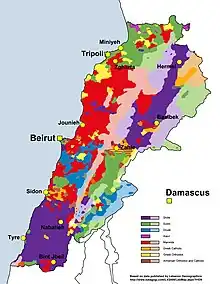
A census in 1921 put the numbers of Shiites at 17.2% (104,947 of 609,069). The last official census in Lebanon in 1932 put the numbers of Shias at 19.6% of the population (154,208 of 785,543).[88] A study done by the Central Intelligence Agency (CIA) in 1985 put the numbers of Shias at 41% of the population (919,000 of 2,228,000).[88][90][87] More recently, the CIA World Factbook estimated that Shia Muslims constitute 31.2% of Lebanon's population in 2022.[89]
Between 1921 and 1988, Shiites maintained the highest fertility rate of all communities, contributing to a rapid increase from 17% to 32%.[91]
| Year | Shiite Population | Total Lebanese Population | Percentage |
|---|---|---|---|
| 1545 | 97,692 | 256,574 | 38% |
| 1861 | 55,120 | 487,600 | 11.3% |
| 1921 | 104,947 | 609,069 | 17.2% |
| 1932 | 154,208 | 785,543 | 19.6% |
| 1956 | 250,605 | 1,407,868 | 17.8% |
| 1975 | 668,500 | 2,550,000 | 26.2% |
| 1988 | 1,325,499 | 4,044,784 | 32.8% |
| 2022 | 1,652,600 | 5,296,814 | 31.2% |
Genetics
In a 2020 study published in the American Journal of Human Genetics, authors showed that there is substantial genetic continuity in Lebanon and the Levant since the Bronze Age (3300–1200 BC) interrupted by three significant admixture events during the Iron Age, Hellenistic, and Ottoman period, each contributing 3%–11% of non-local ancestry to the admixed population. The admixtures were tied to the Sea Peoples of the Late Bronze Age collapse, South or Central Asians and Ottoman Turks respectively.[96] Genetic studies have shown that there are no significant genetic differences between Lebanese Muslims and non-Muslims.[97]
Haplogroup J2 is also a significant marker throughout Lebanon (29%). This marker found in many inhabitants of Lebanon, regardless of religion, signals pre-Arab descendants, although not exclusively. Genealogical DNA testing has shown that 21.3% of Lebanese Muslims (non-Druze) belong to the Y-DNA haplogroup J1 compared with non-Muslims at 17%.[98] Although Haplogroup J1 is most common in Arabian peninsula, studies have shown that it has been present in the Levant since the Bronze Age[99] and does not necessarily indicate Arabian descent.[100] Other haplogroups present among Lebanese Shia include E1b1b (17%), G-M201 (10%), R1b, and T-L206 occurring at smaller, but significant rates.[98]
Notable Lebanese Shia Muslims
 | 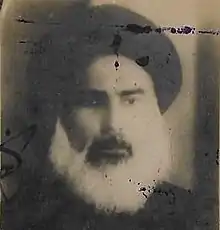 |  |  | 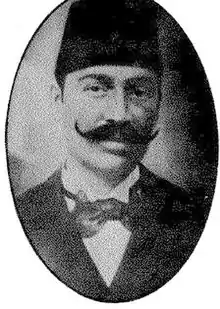 | 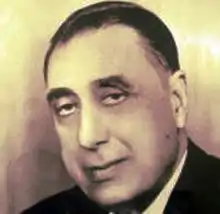 |  | |
_(cropped).jpg.webp) |  |  |  | 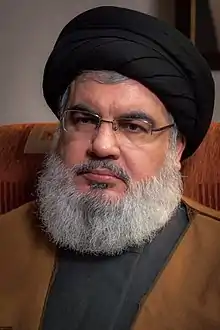 |  |  |
Religious figures
- Muhammad Jamaluddin al-Makki al-ʿĀmili (1334–1385) – Prominent Shia scholar from Jezzine, known as "Shahid Awwal"/"First Martyr"
- Nur-al-Din al-Karaki al-ʿĀmilī (1465–1534) – Shiite scholar and a member of the Safavid court
- Bahāʾ al-dīn al-ʿĀmilī (1547–1621) – Shia Islamic scholar, philosopher, architect, and polymath
- Al-Hurr al-Amili (1624–1693) – prominent Shia muhaddith and compiler of Wasa'il al-Shia
- Abdel Hussein Charafeddine – Spiritual leader, social reformer and leader of nonviolent resistance against the French
- Musa al-Sadr – Spiritual leader and founder of the Amal movement, philosopher and Shi'a religious leader
- Abbas al-Musawi – Shiite scholar and former leader of Hezbollah
- Hassan Nasrallah – Shiite scholar and Leader of Hezbollah
- Ragheb Harb – Shiite scholar and leader of resistance in South Lebanon
- Mohammad Hussein Fadlallah – Spiritual Leader and Shia Grand Ayatollah, former spiritual guide of Islamic Dawa Party in Lebanon
- Ahmad Rida – Shiite scholar and linguist, compiled the first monolingual Arabic dictionary, Matn al-Lugha
- Ahmed Aref El-Zein – Reformist scholar, Arab nationalist and founder of Al-Irfan magazine in 1909
- Sadr al-Din bin Saleh – Shiite scholar and patriarch of the influential Sadr family
Political figures
- Nassif al-Nassar (c. 1750–1781) – Sheikh of Jabal Amel
- Adham Khanjar – Lebanese revolutionary who attempted to assassinate Henri Gouraud in 1923
- Tawfiq Hawlo Haidar – Lebanese revolutionary who took part in the Great Syrian Revolt (1925–1927)
- Adel Osseiran – Speaker of the Lebanese Parliament, and one of the founding fathers of the Lebanese Republic
- Imad Mughniyah – Hezbollah's former Chief of Staff
- Mustafa Badreddine – Former military leader in Hezbollah and both the cousin and brother-in-law of Imad Mughniyah
- Hussein el Husseini – Statesman, co-founder of the Amal movement and Speaker of Parliament
- Sabri Hamade – Former Speaker of the Parliament and political leader
- Kamel Asaad – Former Speaker of the parliament and political leader
- Nabih Berri – Speaker of the Parliament and political leader of Amal Movement
- Abbas Ibrahim – Former General director of the General Directorate of General Security
- Jamil Al Sayyed – Former General director of the General Directorate of General Security
- Hussein al-Musawi – Founder of Islamic Amal militia in 1982
- Assem Qanso – Former leader of the Lebanese Arab Socialist Baath Party
- Ali Qanso – Member of cabinet, former president of the Syrian Social Nationalist Party
- Husayn Muruwwa – Marxist philosopher and former key member of the Lebanese Communist Party
- Mahdi Amel – Marxist philosopher and prominent member of the Lebanese Communist party
- Muhsin Ibrahim – Founder and leader of the Communist Action Organization in Lebanon
Academics
- Hassan Kamel Al-Sabbah – Electrical engineer, mathematician and inventor with patents in television transmission
- Zaynab Fawwaz – Pioneering novelist, playwright, poet and historian of famous women
- Rammal Rammal – Condensed matter Physicist at CNRS
- Ali Chamseddine – Physicist
- Hanan al-Shaykh – Author and Novelist
- Amal Saad-Ghorayeb – Political writer and analyst
- Muhammad Jaber Al Safa – Historian, writer and Arab nationalist[101]
- Fouad Ajami – Former university professor at Stanford University
Artists, singers and journalists
- Haifa Wehbe – Singer and actress, considered one of the best-known artists in the Arab world
- Layal Abboud – Pop singer, dancer and fit model
- Rima Fakih – Model and winner of the 2010 Miss USA title; later converted from Shia Islam to Maronite Christianity
- Ragheb Alama – Singer, composer, television personality, and philanthropist
- Assi El Helani – Famous singer
- Amal Hijazi – Singer and former actress
- May Hariri – Model, actress, and singer
- Rima Karaki – Television show host
- Melissa – Singer
- Alissar Caracalla – Lebanese Dance choreographer
- Mouhamed Harfouch – Brazilian-Lebanese actor
See also
References
- Wehr, Hans (1976). Cowan, J Milton (ed.). Dictionary of Modern Written Arabic (Third ed.). Ithaca, New York. p. 1101. ISBN 0-87950-001-8. OCLC 2392664.
متوال mutawālin successive, consecutive, uninterrupted, incessant; -- (pl. متاولة matāwila) member of the Shiite sect of Metualis in Syria
{{cite book}}: CS1 maint: location missing publisher (link) - Massignon, Louis. "Mutawālī". Encyclopaedia of Islam, First Edition (1913-1936). doi:10.1163/2214-871X_ei1_SIM_4996.
- Riad Yazbeck. Return of the Pink Panthers?. Mideast Monitor. Vol. 3, No. 2, August 2008
- Zoi Constantine (2012-12-13). "Pressures in Syria affect Alawites in Lebanon – The National". Thenational.ae. Retrieved 2013-01-05.
- "Lebanon-Religious Sects". Global security.org. Retrieved 2010-08-11.
- "March for secularism; religious laws are archaic". NOW News. Retrieved 2010-08-11.
- "Fadlallah Charges Every Sect in Lebanon Except his Own Wants to Dominate the Country". Naharnet. Retrieved 2010-08-11.
- "Aspects of Christian-Muslim Relations in Contemporary Lebanon". Macdonald.hartsem.edu. Archived from the original on 2011-07-25. Retrieved 2010-08-11.
- Maroon, Habib (31 March 2013). "A geneticist with a unifying message". Nature Middle East. doi:10.1038/nmiddleeast.2013.46.
- Shahid, Irfan (1984). Rome and the Arabs: A Prolegomenon to the Study of Byzantium and the Arabs. Dumbarton Oaks. ISBN 9780884021155.
- E. G. Hardy, Roman Laws and Charters, New Jersey 2005, p.95
- Irfan Shahid (2010). Byzantium and the Arabs in the Sixth Century, Volume 2, Part 2 (illustrated ed.). Harvard University Press. ISBN 9780884023470.
- W., Harris, William (2012). Lebanon: a history, 600–2011. New York: Oxford University Press. ISBN 9780195181128. OCLC 757935847.
{{cite book}}: CS1 maint: multiple names: authors list (link) - Al-Muhajir, Jaafar (1992). The Foundation of the History of the Shiites in Lebanon and Syria (in Arabic). Beirut: Dar al-Malak.
- ABISAAB, R. (1999). "SH?'ITE BEGINNINGS AND SCHOLASTIC TRADITION IN JABAL 'ĀMIL IN LEBANON". The Muslim World. 89: 1, 21. doi:10.1111/j.1478-1913.1999.tb03666.x.
- Mukaddasi, Description of Syria, 1886, p. 28
- Hamade, Mohammad (2013). History of Shiites in Lebanon, Syria and Jazira in the Middle Ages (in Arabic). Baalbek: Dar Baha'uddine al-'Amili.
- Brett, Michael (2017). The Fatimid Empire. Edinburgh University Press. ISBN 9780748640775.
- Daftary, Farhad (2007). The Isma'ilis: Their History and Doctrines. Cambridge University Press. ISBN 9781139465786.
- Canard, Marius (1971). "Ḥamdānids". In Lewis, B.; Ménage, V. L.; Pellat, Ch. & Schacht, J. (eds.). Encyclopaedia of Islam. Volume III: H–Iram (2nd ed.). Leiden: E. J. Brill. pp. 126–131. OCLC 495469525.
- Bianquis, Thierry (1993). "Mirdās, Banū or Mirdāsids". In Bosworth, C. E.; van Donzel, E.; Heinrichs, W. P. & Pellat, Ch. (eds.). Encyclopaedia of Islam. Volume VII: Mif–Naz (2nd ed.). Leiden: E. J. Brill. pp. 115–123. ISBN 978-90-04-09419-2.
- Bianquis, T. (2002). "Waththab b. Sabik al-Numayri". In Bearman, P. J.; Bianquis, Th.; Bosworth, C. E.; van Donzel, E. & Heinrichs, W. P. (eds.). Encyclopaedia of Islam. Volume XI: W–Z (2nd ed.). Leiden: E. J. Brill. ISBN 978-90-04-12756-2.
- Heidemann, S. (2005). "Numayrid Raqqa: Archaeological and Historical Evidence of a 'Dimorphic State' in the Bedouin Fringes of the Fatimid Empire". In Vermeulen, U.; Van Steenbergen, J. (eds.). Egypt and Syria in the Fatimid, Ayyubid and Mamluk Eras, Volume 4. Leuven, Dudley: Peeters Publishers.
- Momen, Moojan (1985). An Introduction to Shiʻi Islam The History and Doctrines of Twelver Shiʻism. Yale University Press. ISBN 978-0300034998.
- Bianquis, Thierry (1993). "Mirdās, Banū or Mirdāsids". In Bosworth, C. E.; van Donzel, E.; Heinrichs, W. P. & Pellat, Ch. (eds.). Encyclopaedia of Islam. Volume VII: Mif–Naz (2nd ed.). Leiden: E. J. Brill. pp. 115–123. ISBN 978-90-04-09419-2.
- Mallett, Alex (2014). "ʿAmmār, Banū (Syria)". In Fleet, Kate; Krämer, Gudrun; Matringe, Denis; Nawas, John; Rowson, Everett (eds.). Encyclopaedia of Islam (3rd ed.). Brill Online. ISSN 1873-9830.
- Harris 2011, p. 62
- Al-Muhajir, Jaafar (2017). The Imami Jurisprudence: its Origins and Schools. Center Of Civilization For the Development Of Islamic Thought. ISBN 9786144271254.
- Al-Muhajir, Jaafar (2004). Husam al-Din Bshara: Emir of "Jabal Amel". Baalbek, Lebanon.
{{cite book}}: CS1 maint: location missing publisher (link) - Humphreys, R. Stephen (1977). From Saladin to the Mongols: The Ayyubids of Damascus, 1193-1260. SUNY Press. ISBN 9780873952637.
- Ḥamādah, Saʻdūn (2008). The History of Shiites in Lebanon, Volume one (in Arabic). Dar Al Khayal. ISBN 9789781025488.
{{cite book}}: CS1 maint: location missing publisher (link) - Harris 2011, p. 83-84
- Winter, Stefan (2016). A History of the 'Alawis: From Medieval Aleppo to the Turkish Republic. Princeton University Press. ISBN 9781400883028.
- Winter, Stefan (1999). Shams al-Din Muhammad ibn Makki "al-Shahid al-Awwal" (d. 1384) and the Shi'ah of Syria (PDF). The University of Chicago. Retrieved 25 September 2014.
- Winter, Stefan (11 March 2010). The Shiites of Lebanon under Ottoman Rule, 1516–1788. Cambridge University Press. ISBN 9781139486811.
- Stefan Winter, "The Kızılbaş of Syria and Ottoman Shiism" in Christine Woodhead, ed., The Ottoman World (London: Routledge, 2012), 171–183.
- Matthee, Rudi (2014). "The Ottoman-Safavid War of 986-998/1578-90: Motives and Causes". In Karpat, Kemal; Balgamış, Deniz (eds.). International Journal of Turkish Studies. Vol. 20, Nos 1& 2.
- El-Khazen, Farid (2000). The Breakdown of the State in Lebanon, 1967-1976. Harvard University Press. ISBN 9780674081055.
- de Chasseboeuf de Volney, Comte Constantin François (1782). Voyage en Syrie et en Egypte, pendant les années 1783, 1784 et 1785: avec deux cartes géographiques et deux planches gravées représentant les Ruines du Temple du Soleil à Balbek, et celles de la ville de Palmyre, dans le désert de Syrie, volume 1 (in French). p. 335.
- Abu-Husayn, Abdul-Rahim (1985). Provincial Leaderships in Syria, 1575–1650. Beirut: American University of Beirut. ISBN 978-0-8156-6072-9. OCLC 242675094.
- Reisinezhad, Arash (2018). The Shah of Iran, the Iraqi Kurds, and the Lebanese Shia. Springer. doi:10.1007/978-3-319-89947-3. ISBN 9783319899473. S2CID 187523435.
- Kheirabadi Masoud (2000). Iranian Cities: Formation and Development. Syracuse University Press. pp. 47.
- Gharbieh, Hussein M. (1996). Political awareness of the Shi'ites in Lebanon: the role of Sayyid 'Abd al-Husain Sharaf al-Din and Sayyid Musa al-Sadr (PDF) (Doctoral). Durham: Centre for Middle Eastern and Islamic Studies, University of Durham.
- Winter 2010, p. 142.
- "Welcome to Encyclopaedia Iranica".
- Elliot, Warburton (1843). The Crescent and the Cross. B. Tauchnitz. pp. 265–266.
- Stefan Winter, The Kızılbaş of Syria and Ottoman Shiism. in Christine Woodhead (ed.), The Ottoman World (London: Routledge, 2011). p. 171-183.
- Weiss, Max (2010). In the Shadow of Sectarianism: Law, Shi'ism, and the Making of Modern Lebanon. Cambridge, MA: Harvard University Press. pp. 58–59. ISBN 978-0674052987.
- Siklawi, R. (2014). The social and political identities of the shi'i community in lebanon. Arab Studies Quarterly, 36(4). https://doi.org/10.13169/arabstudquar.36.4.0278
- Tarazi Fawaz, Leila (1994). An Occasion for War: Civil Conflict in Lebanon and Damascus in 1860. University of California Press. ISBN 9780520200869.
- Chalabi, ( ., Tamara (2006). The Shiʿis of Jabal ʿĀmil and the New Lebanon: Community and Nation-State, 1918–1943. New York: Palgrave. pp. 115–138. ISBN 978-1-4039-7028-2.
- Antonius, George (1938) The Arab Awakening. The Story of the Arab National Movement. Hamish Hamilton. (1945 edition). pp.108,109
- Khazem, Youssef (2017). Abdul Karim al-Khalil: The First Beacon of The Arabs, 1884 - 1915 (in Arabic). DAR AL-FARABI FOR PUBLISH. ISBN 9796500283012.
- Firro, Kais (2002). Inventing Lebanon: Nationalism and the State Under the Mandate. London and New York: I. B. Tauris. pp. 159, 166. ISBN 978-1860648571.
- Hage Ali, Mohanad (2018). Nationalism, Transnationalism, and Political Islam. Springer. ISBN 9783319604268.
- Turjman, Ihsan Salih; Tamari, Salim (2015). Year of the Locust: A Soldier's Diary and the Erasure of Palestine's Ottoman Past. University of California Press. ISBN 9780520287501.
- Halawi, Majed (1992). A Lebanon Defied - Musa Al-sadr And The Shi'a Community. Boulder - San Francisco - Oxford: Westview Press. p. 122. ISBN 978-0813383187.
- Sbaiti, Nadya (2008). Lessons in History: Education and the Formation of National Society in Beirut, Lebanon 1920-1960s. Georgetown University: PhD diss. p. 2.
- Sayed, Linda (2019-09-11). "Education and Reconfiguring Lebanese Shiʿi Muslims into the Nation-State during the French Mandate, 1920–43". Die Welt des Islams. 59 (3–4): 282–312. doi:10.1163/15700607-05934P02. ISSN 0043-2539. S2CID 204456533.
- Sbaiti, Nadya (2013). ""A Massacre Without Precedent": Pedagogical Constituencies and Communities of Knowledge in Mandate Lebanon". The Routledge handbook of the history of the Middle East mandates. Schayegh, Cyrus,, Arsan, Andrew. London. p. 322. ISBN 978-1-315-71312-0. OCLC 910847832.
{{cite book}}: CS1 maint: location missing publisher (link) - Thompson, Elizabeth (2000). Colonial Citizens: Republican Rights, Paternal Privilege, and Gender in French Syria and Lebanon. New York: Columbia University Press. pp. 1. ISBN 9780231106610.
- Watenpaugh, Keith (2006). Being Modern in the Middle East: Revolution, Nationalism, Colonialism, and the Arab Middle Class. Princeton: Princeton University Press. p. 213. ISBN 0691155119.
- Firro, Kais (2009). Metamorphosis of the Nation (al-Umma): The Rise of Arabism and Minorities in Syria and Lebanon, 1850–1940. Portland, OR: Sussex Academic Press. p. 94. ISBN 9781845193164.
- Sayed, Linda (2013). Sectarian Homes: The Making of Shi'I Families and Citizens under the French Mandate, 1918–1943. Columbia University: PhD diss. pp. 78–81.
- Weiss, Max (2010). In the Shadow of Sectarianism. pp. 61–62.
- Weiss, Max (2010). In the Shadow of Sectarianism. p. 36.
- Danny Rubinstein (6 August 2006). "The Seven Lost Villages". Haaretz. Archived from the original on 2007-10-01. Retrieved 2015-01-12.
- Lamb, Franklin. Completing The Task Of Evicting Israel From Lebanon 2008-11-18.
- "Report: Hizbullah Training Shiite Syrians to Defend Villages against Rebels — Naharnet". naharnet.com. Retrieved 2015-01-12.
- Zoi Constantine (2012-12-13). "Pressures in Syria affect Alawites in Lebanon – The National". Thenational.ae. Retrieved 2013-01-05.
- "'Lebanese Alawites welcome Syria's withdrawal as 'necessary' 2005, The Daily Star, 30 April". dailystar.com.lb. Retrieved 2015-01-12.
The Alawites have been present in modern-day Lebanon since the 16th century and are estimated to number 100,000 today, mostly in Akkar and Tripoli.
- Jackson Allers (22 November 2008). "The view from Jabal Mohsen". Menassat.com. Retrieved 18 January 2016.
- "Lebanon: Displaced Allawis find little relief in impoverished north". Integrated Regional Information Networks (IRIN). UNHCR. 5 August 2008. Retrieved 18 January 2016.
- "Lebanon: Displaced families struggle on both sides of sectarian divide". Integrated Regional Information Networks (IRIN). UNHCR. 31 July 2008. Retrieved 18 January 2016.
- David Enders (13 February 2012). "Syrian violence finds its echo in Lebanon". McClatchy Newspapers. Retrieved 18 January 2016.
- Salibi, Kamal S. (1990). A House of Many Mansions: The History of Lebanon Reconsidered. University of California Press. pp. 118–119. ISBN 0520071964.
- Mahamid, Hatim (September 2006). "Isma'ili Da'wa and Politics in Fatimid Egypt" (PDF). Nebula. p. 13. Retrieved 2013-12-17.
- Salibi, Kamal S. (1990). A House of Many Mansions: The History of Lebanon Reconsidered. University of California Press. p. 137. ISBN 0520071964.
- "Lebanon – Religious Sects". GlobalSecurity.org. Retrieved 2013-12-17.
- "FIRST VISIT TO FOLLOWERS". Ismaili.net. 4 August 1957. Retrieved 2013-12-17.
- Collelo, Thomas (1 January 2003). "Lebanon: A Country Study". In John C. Rolland (ed.). Lebanon: Current Issues and Background. Hauppage, NY: Nova Publishers. p. 74. ISBN 1590338715.
- Bureau of Democracy, Human Rights and Labor (27 July 2012). "International Religious Freedom Report for 2011" (PDF). United States Department of State. Retrieved 2015-01-12.
- Khalaf, Mona Chemali (8 April 2010). "Lebanon" (PDF). In Sanja Kelly and Julia Breslin (ed.). Women's Rights in the Middle East and North Africa: Progress Amid Resistance. New York, NY: Freedom House. p. 10. Retrieved 2015-01-12.
- "Lebanon 2008 – 2009: Towards a Citizen's State" (PDF). The National Human Development Report. United Nations Development Program. 1 June 2009. p. 70. Retrieved 2015-01-12.
- Ohrstrom, Lysandra (2 August 2007). "War with Israel interrupts rare industrial success story". The Daily Star (Lebanon). Retrieved 2013-12-17.
- Lebanon Ithna'ashari Shias Overview World Directory of Minorities. June 2008. Retrieved 28 December 2013.
- "2012 Report on International Religious Freedom – Lebanon". United States Department of State. 20 May 2013. Retrieved 17 January 2016.
- "Contemporary distribution of Lebanon's main religious groups". Central Intelligence Agency. Retrieved 2013-12-15.
- "Lebanon: people and society"
- Fawwaz Traboulsi, Social Classes and Political Power in Lebanon (Beirut: Heinrich Böll Stiftung, 2014)
- Farha, Mark (2019). Lebanon. Cambridge University Press. p. 175. ISBN 9781108471459.
- Yusri Hazran (June 2009). The Shiite Community in Lebanon: From Marginalization to Ascendancy (PDF). Brandeis University. Retrieved 17 January 2016.
- Yahya, Houssam (2015). La protection sanitaire et sociale au Liban (1860-1963) (PDF) (Thesis). Université Nice Sophia Antipolis.
- Fahrenthold, Stacy (2019). Between the Ottomans and the Entente: The First World War in the Syrian and Lebanese Diaspora, 1908-1925. Oxford University Press. ISBN 9780190872151.
- Abdel Nour, Antoine (1982). Introduction à l'histoire urbaine de la Syrie Ottomane (XVIe-XVIIIe siècle). Beirut: Publications de l'Université Libanaise. p. 80.
- Haber, Marc; Nassar, Joyce; Almarri, Mohamed A.; Saupe, Tina; Saag, Lehti; Griffith, Samuel J.; Doumet-Serhal, Claude; Chanteau, Julien; Saghieh-Beydoun, Muntaha; Xue, Yali; Scheib, Christiana L.; Tyler-Smith, Chris (2020). "A Genetic History of the Near East from an aDNA Time Course Sampling Eight Points in the Past 4,000 Years". American Journal of Human Genetics. 107 (1): 149–157. doi:10.1016/j.ajhg.2020.05.008. PMC 7332655. PMID 32470374.
- Zalloua, Pierre A., Y-Chromosomal Diversity in Lebanon Is Structured by Recent Historical Events, The American Journal of Human Genetics 82, 873–882, April 2008
- Haber, Marc; Platt, Daniel E; Badro, Danielle A; Xue, Yali; El-Sibai, Mirvat; Bonab, Maziar Ashrafian; Youhanna, Sonia C; Saade, Stephanie; Soria-Hernanz, David F (March 2011). "Influences of history, geography, and religion on genetic structure: the Maronites in Lebanon". European Journal of Human Genetics. 19 (3): 334–340. doi:10.1038/ejhg.2010.177. ISSN 1018-4813. PMC 3062011. PMID 21119711.
- Skourtanioti, Eirini; Erdal, Yilmaz S.; Frangipane, Marcella; Balossi Restelli, Francesca; Yener, K. Aslıhan; Pinnock, Frances; Matthiae, Paolo; Özbal, Rana; Schoop, Ulf-Dietrich; Guliyev, Farhad; Akhundov, Tufan; Lyonnet, Bertille; Hammer, Emily L.; Nugent, Selin E.; Burri, Marta; Neumann, Gunnar U.; Penske, Sandra; Ingman, Tara; Akar, Murat; Shafiq, Rula; Palumbi, Giulio; Eisenmann, Stefanie; d'Andrea, Marta; Rohrlach, Adam B.; Warinner, Christina; Jeong, Choongwon; Stockhammer, Philipp W.; Haak, Wolfgang; Krause, Johannes (2020). "Genomic History of Neolithic to Bronze Age Anatolia, Northern Levant, and Southern Caucasus". Cell. 181 (5): 1158–1175.e28. doi:10.1016/j.cell.2020.04.044. PMID 32470401. S2CID 219105572.
- Haber, Marc; Doumet-Serhal, Claude; Scheib, Christiana; Xue, Yali; Danecek, Petr; Mezzavilla, Massimo; Youhanna, Sonia; Martiniano, Rui; Prado-Martinez, Javier; Szpak, Michał; Matisoo-Smith, Elizabeth; Schutkowski, Holger; Mikulski, Richard; Zalloua, Pierre; Kivisild, Toomas; Tyler-Smith, Chris (2017-08-03). "Continuity and Admixture in the Last Five Millennia of Levantine History from Ancient Canaanite and Present-Day Lebanese Genome Sequences". The American Journal of Human Genetics. 101 (2): 274–282. doi:10.1016/j.ajhg.2017.06.013. ISSN 0002-9297. PMC 5544389. PMID 28757201.
- Chalabi, Tamara (2006). The Shi'is of Jabal `Amil and the New Lebanon: Community and Nation-State, 1918-1943, p.34